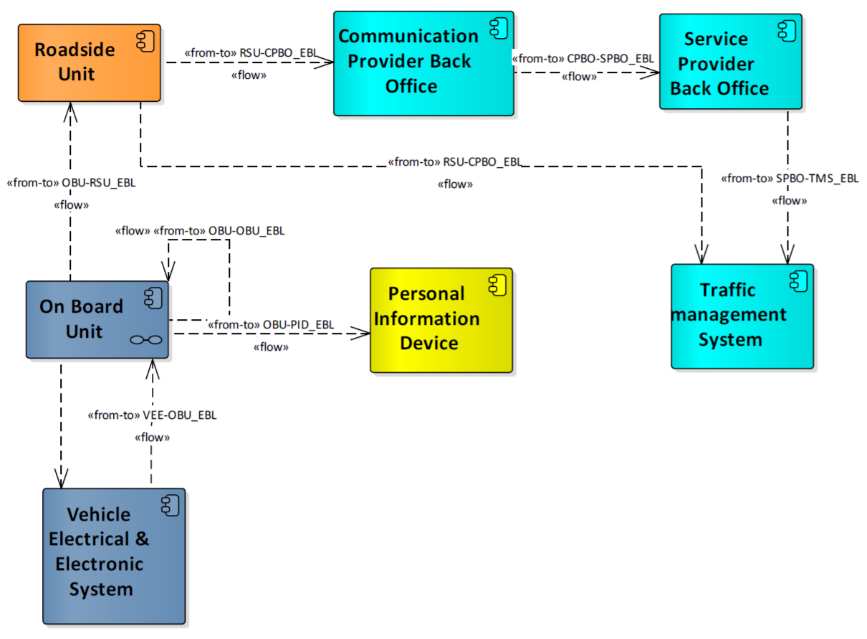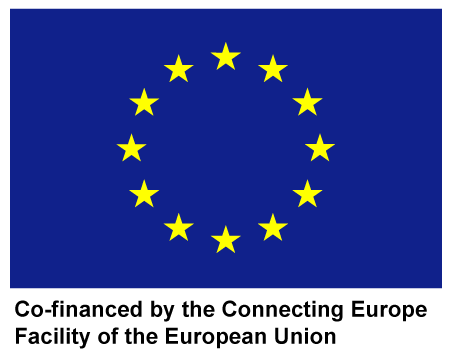
Cooperative Urban
Mobility Portal
Explore Connected and Cooperative Mobility

Cooperative
Urban Mobility Portal
Explore Connected and Cooperative Mobility
Emergency Brake Light (EBL)
Emergency Brake Light aims to avoid (fatal) rear end collisions, which can occur if a vehicle ahead suddenly brakes, especially in dense driving situations or in situations with decreased visibility. The driver is warned before s/he is able to realize that the vehicle ahead is braking hard, especially if s/he does not see the vehicle directly (vehicles in between).
Participating actors in Emergency Brake Light include vehicle drivers, who receive emergency brake light warning on the vehicle, road operators/ traffic managers, who may signal the existence of a sudden slowdown, service providers, who disseminate the emergency brake light warning to vehicle drivers, and other organizations charged with repair, maintenance and/ or cleaning who may act on the sudden traffic slowdown information.
The objective of Emergency Brake Light is to warn all following vehicles of a sudden slowdown of the traffic so limiting the risk of longitudinal collision.
Invisible
Your content goes here. Edit or remove this text inline or in the module Content settings. You can also style every aspect of this content in the module Design settings and even apply custom CSS to this text in the module Advanced settings.
Business models
Taking into account various stakeholders’ views, a list of business model blueprints that address current or future challenges of urban areas, together with their operating and value-capture scenarios depicting the inner-workings of the business models, and the exchange of costs-benefits among stakeholders, have been created for the Emergency Brake Light service.
Invisible
Your content goes here. Edit or remove this text inline or in the module Content settings. You can also style every aspect of this content in the module Design settings and even apply custom CSS to this text in the module Advanced settings.
Architecture
ITS-G5
In case of ITS-G5 communication technologies the On-Board Unit broadcasts its information needed for vehicle control warning and vehicle state information. The basic use case is based on Vehicle-to-Vehicle communication only in which the ego vehicle application uses the information from the Vehicle Electrical & Electronic System (VEES) to construct the messages to be broadcasted out of the On-Board Unit. The application is triggered based on information from VEES. Other vehicles receiving these messages notify the driver with a warning indication on the vehicle Human Machine Interface. In addition, if cooperative infrastructure is available, the received messages can be received with Roadside Units. This will improve local traffic awareness at Traffic Management Systems for example at cooperative intersection or cooperative highway corridors. From the Roadside Unit the information can be forwarded to Communication Provider Back Office. The complete chain includes Communication Provider Back Office connections to Service Provider Back Office, and from this a connection to a local Traffic Management System can be provided.
Cellular
In case of cellular communication technologies the On-Board Unit broadcasts its information needed for vehicle control warning and vehicle state information. The basic use case is based on Vehicle-to-Vehicle communication only in which the ego vehicle application uses the information from the Vehicle Electrical & Electronic System (VEES) to construct the messages to be broadcasted out of the On-Board Unit. The application is triggered based on information from VEES. Other vehicles receiving these messages notify the driver with a warning indication on the vehicle Personal Information Device. The Personal Information Device can also be an integrated part of the vehicle, example a touchscreen/ Human Machine Interface for activating/ deactivating and configuring the application.
Invisible
Your content goes here. Edit or remove this text inline or in the module Content settings. You can also style every aspect of this content in the module Design settings and even apply custom CSS to this text in the module Advanced settings.
Architecture schema
Invisible
Your content goes here. Edit or remove this text inline or in the module Content settings. You can also style every aspect of this content in the module Design settings and even apply custom CSS to this text in the module Advanced settings.
Suppliers
Suppliers of components and solutions for the Emergency Brake Light service include research institutes, such as CTAG, as well as private companies, such as NeoGLS, Dynniq, Traffic Technique,and Swarco.
Invisible
Bordeaux
In Bordeaux the Emergency Brake Light service is implemented using ITS-G5 technology. It works by sending hard-brake warning from vehicle to vehicle. In addition, 11 RSUs have been deployed being able to receive this alert and forward it to other users not equipped with an OBU, but using the local App on their smart devices connected via cellular communication. The service provider of the EBL service is NeoGLS and the service is available through the App “CTD – Connected Mobility”.
Invisible
Vigo




This website has received funding from the European Union’s Horizon 2020 Research and Innovation Programme
under Grant Agreement number 723311.
